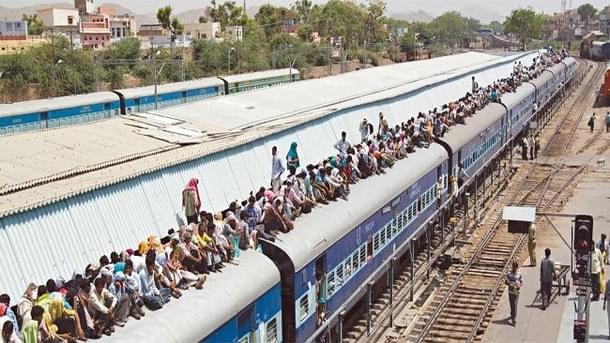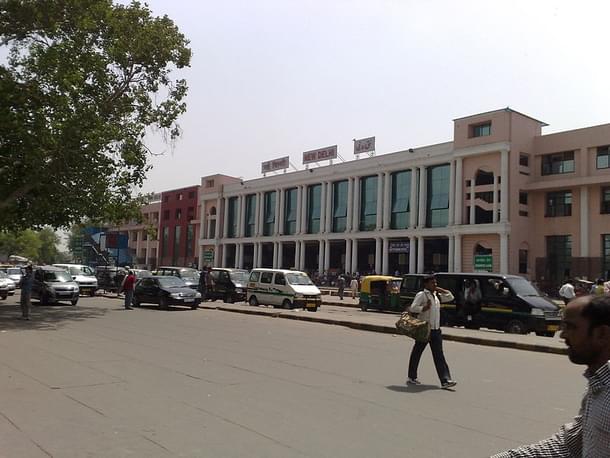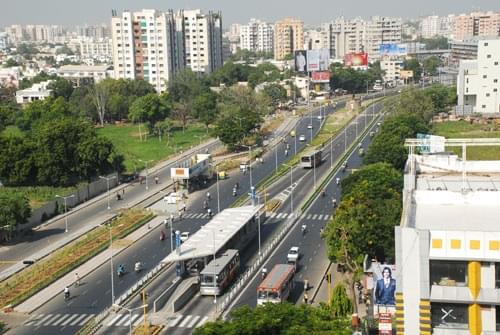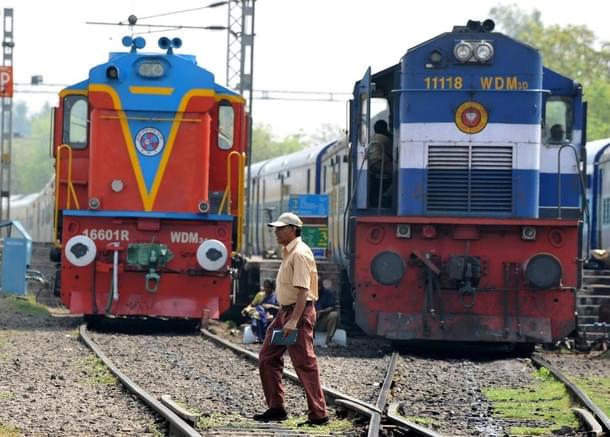Books
Co-opting the Railways to Build India's Smart Cities
Shailesh Pathak
Jan 24, 2015, 11:30 AM | Updated Feb 18, 2016, 12:11 PM IST
Save & read from anywhere!
Bookmark stories for easy access on any device or the Swarajya app.


An action plan to implement railway station based smart cities.
Railway station modernisation is a priority for the Prime Minister Narendra Modi and Railways Minister Suresh Prabhu. Smart cities and urban renewal are equally important for PM Modi and Urban Development Minister Venkaiah Naidu. This is an action plan to implement both jointly, leading to a quick increase in jobs, and execution with speed and scale.
This would also lead to women’s safety. What’s needed is a meeting of minds between Railways and other Central ministries, State Government and the concerned Urban Local Government. This note talks about how to implement and how to finance railway station based smart cities, along with a proposed time line and execution structure.

Opportunity
Most of India’s 53 million-plus cities (above 10 lakh population) have railway stations that are centrally located. They should ideally be creating the most jobs in the city as economic hubs. They should also be the hub of all mass transit within the city, including buses, taxis, auto-rickshaws, para-transit, as well as airport links and metro systems, wherever present.
However, most Indian railway stations have a disorderly and under-productive area and need urgent reform & improvement. While railway station land may be leveraged for generating resources, redeveloping the area is much more significant to the city in question, and should be looked at as an urban renewal project instead of railway stations alone.
We need to change the lens from a Railways perspective to a City perspective, indeed, from a MoUD (Ministry of Urban Development) perspective to a state government and city government perspective.
The new Union Government has made job creation its highest priority. This would be driven by a clear focus on city development. Breaking existing silos, one would have to work with a particular city’s and state’s needs as the core objective, instead of the desire of ministries in Delhi.
Smart cities: options
The Smart Cities initiative was last reviewed by the PM on 29 December 2014. Smart cities could be created in two ways: first, urban renewal with smart cities built around railway stations as integrated transport hubs, or second, new township development in outlying areas.
While the risk of new township development is higher, the execution challenges in smart cities around railway stations are complex. The latter involves three distinct sets of entities – the city and state government, the Railways, private land owners and stakeholders in the area.
Job creation would be maximum in the railway station smart city option. Such smart cities would immediately lead to a large number of jobs; new townships in suburbs would take much longer for such job creation.
Transit Oriented Development
There is a compelling case for making a smart city around the economic zone of influence of the transport hub built around the railway station. This smart city would have ‘live, work, play’ components. This would lead to ‘Transit Oriented Development’ (TOD), emulating major global cities.

As an example, Singapore has integrated ‘land use’ with transport and has ensured that intense economic activities are located in the influence zone of trunk infrastructure of mass transit. The city-state was characterised by slums and abysmal urban amenities in 1965. Today, its road density is less than Delhi but Singapore has no congestion because of TOD model (and congestion pricing of cars).
Its affordable housing programme is exemplified by 80% population residing in HDB (Housing Development Board) built high-rise housing complexes within walking distance of public transport nodes.
TOD reduces trip length and trip numbers, reduces commute time, reduces congestions and reduces energy footprint. It makes cities efficient, improves its ease of doing business and utilises land more efficiently. Indeed, by encouraging walking and cycling, it improves the public health profile of a city, with less lifestyle-induced diseases.
Strategy
To ensure speed and scale, it is important to start small, succeed and upscale rapidly. One may aim at developing 10 smart cities around railway stations by 2018. Successes could be replicated 2017 onwards in other willing cities and states.
Action Plan
1. In addition to the Railways, willing Chief Ministers of state governments are essential. Hence, after an initial announcement by Prime Minister, the Ministers for Railways, Urban Development, Roads Transport & Highways, and any others, may announce this scheme in a joint press conference, for the first 5 Chief Ministers who would write in with their commitment for such smart cities around railway stations.
This will promote virtuous competition among states, and will ensure full support and commitment from state and city government officials.
2. In these 5 early responding states, 2 cities each with centrally located railway stations may be chosen jointly by the Chief Minister and the Railways Minister.
3. An area around the influence zone of the 10 stations (preferably an area within walking distance, typically a grid of 1×1 km, or 2×2 km) would constitute their smart city.
4. In cities which also have a metro or a BRT project, railway stations having confluence of Metro/BRT would have added advantage in such TOD project.

This smart city area would have three kinds of land and property:
1.Land belonging to Railways
2.Land and property owned by Government entities: State, city and perhaps central, including their public sector units.
3.Privately held land and property (includes private trusts etc.)
The entire land parcel would be taken as a single planning unit.
A smart city would be planned for the entire zone of economic influence. The design objectives would be:
1.Generate many more jobs at all income levels, to make this smart city around the railway station as an engine of growth.
2.The smart city to be the transport hub for the city, incorporating multi-modal interchanges among train, bus, auto-rickshaws, para-transit, taxis and other vehicles, and metro/airport links wherever present. As far as possible, these interchanges should be seamless, and if possible, accessible at different levels of the same structure. The bus station of the city must be integrated with such a smart city’s railway station.
3.Improve public safety and security, especially women’s safety.
4.Improve the ease of doing business in a city by economies of agglomeration including advantage of cluster and functional networks.
5.Reduce congestion (e.g. less commute time) and trip length in the city.
6.Reduce energy footprint of the city for sustainability.
7.Aesthetically improve the looks of the city.
Types of activities for these objectives
1. All three elements of ‘Live, Work, Play’ to be incorporated in a high-rise format.
2. Mixed use: commercial offices, retail business centres, hospitality Industries that will generate jobs.
3. Public parks and spaces, as well as entertainment & convention centres to be an integral part.
4. Locate housing projects, especially single women’s housing complexes and women’s hostels, and wherever possible, affordable housing projects within the smart city area.
Since the entire smart city activity is planned around railway stations, a direct advantage would be reduction in number of trips and trip length. This would also reduce congestion in other parts of the city.
Railways should be willing to use or expand their tracks for city-suburban rail because such urban renewal would increase ridership of their suburban rail. The carbon footprint of cities would decrease.
Aesthetically too, it would amount to a major improvement as currently, perhaps the most unattractive portion of a city is around its railway station and bus station. The biggest gainer would be the city concerned, which would add to its competitive advantage and create many more jobs.
Planning exercise would entail
1.For the smart city area, raise the FSI (Floor Space Index) and density, encouraging vertical growth in the area around the railway station.
2. Allow mixed land-use.
3.Remove any existing ceiling in revenue laws such as 10% commercial utilisation etc.
All these three would be done by the state and city government entities, and hence they should be driving the process, with the Railways as partners.
Financing
Land around railway stations in large cities is usually badly utilised and expensive. Hence, if FSI is raised and restriction on commercial utilisation of land parcels is removed, self-financing is easy with intelligent land monetisation.
Such smart cities around railway stations would finance themselves to a large extent. Good examples are modernisation of bus stations in Vadodara and Ahmedabad, where FSI was raised and ceiling on commercial utilisation of land at 10% was removed.
Similarly, New Delhi’s East Kidwai Nagar redevelopment has 86 acres being redeveloped to build over 4700 homes, along with commercial use of 10% of the land. This requires no budgetary resources.
Another example is the New Moti Bagh residential complex in New Delhi. Out of about 144 acre of Government land in which old two storey government tenements existed, roughly four acre was auctioned to a private player with permission for commercial use – the Leela Palace hotel. This generated over Rs 600 crore, more than enough to cover construction and maintenance cost of making over 1000 high quality homes for senior government officials.
Balance funding, if required, may be arranged as grant from state/city authorities or Central Government under its scheme of developing smart cities.
Many expert bodies have recommended land monetisation for urban renewal. Of particular importance are following:
1. High Powered Committee for Investment in urban sector led by Dr. Isher J. Ahluwalia, March 2011.
2. Vijay Kelkar Committee on Roadmap for Fiscal Consolidation, Sept 2012 recommends as follows:
“Over the next 24-36 months, there is yet another policy instrument for raising resources for development and that is monetizing government’s unutilized and under-utilized land resources. These resources can finance infrastructure needs particularly in urban areas. Such a policy has been effectively utilized in many countries including USA, France, Canada, Australia and China”…
Project execution vehicles
Smart cities around railway stations are not possible if states do not have requisite buy-in, both in terms of outcomes and in terms of measures that are essential to achieve the results, like change in the planning norms.
Hence, as suggested earlier, after an initial announcement by the Prime Minister, the three concerned Union Ministers: Railways, Urban Development and Road Transport, may announce that in the first phase, the project would be undertaken ONLY in those first 5 States, where the State’s Chief Minister commits full support.
This would motivate a virtuous competitive spirit among dynamic CMs who are first to respond to this opportunity.
The tried-and-tested joint-ownership model is from Metro development, where both state and central government have a 50-50 shareholding. Five such SPVs (special purpose vehicle) need to be created for the five states which would take up two smart cities each around railway stations.
These 10 smart cities around railway stations would be executed through Special Purpose Vehicles (SPVs) in which the concerned state government and union government may take equity on 50:50 basis.
Once the smart cities have been implemented, at the Operations & Management (O&M) stage, private-public-partnerships (PPPs) would yield huge financial returns for both shareholders. Such PPP bidding-out should happen ONLY after complete execution, when there is cash flow visibility.
Developing these 10 smart cities around railway stations would be extremely complex with substantial early stage risk, for which private bidders would submit very high bids in the pre-cash flow stage. A government 50-50 SPV can undertake such early stage risks much better.
The implementing government-owned SPVs would:
1. Design the smart cities well with a special focus on women.
2.Be responsible for building of the trunk infrastructure.
3.Auction/allot land/land parcels/FSI to private parties for projects.
Private parties would:
1. Execute individual projects (commercial office space, business & convention centres, retail and shopping complexes, women’s residential complexes and other housing etc.) within the smart city.
2. Once fully completed, the smart city’s O&M may also be given over on PPP structures to private parties.
Land acquisition?
There would be NO land acquisition, only land pooling. As mentioned earlier, there would be three kinds of land, belonging to Railways, state/city/union governments, and private parties. For the last category, land pooling would be the preferred option.
Land pooling has been successful in Gujarat’s town planning schemes. It has been introduced in various cities around the country, including DDA (Delhi Development Authority) recently.
The new state of Andhra Pradesh intends to develop its new capital in the Vijaywada-Guntur region through land pooling. Private landowners would be incentivised by such land pooling, under the smart city’s master plan, and would benefit from raised FSI and relaxation in land-use.
In case such private land-holders are not willing to be part of urban renewal, the opportunity cost of holding under-developed land in the smart city around railway stations should be made prohibitively high.
This could include a punitive tax on such under-developed land. For the few recalcitrant hold-outs, eminent domain could be used as the last option for land acquisition.
Additional infrastructure?
The proposed urban renewal as a smart city will definitely need to incorporate the increased requirement of basic amenities like broadband, water & waste management, sewage treatment, and electricity.
These would be incorporated at the project report stage, including investment requirements. The implementing SPV, along with the city government may collect incidental development charges for revenue generation.
Human populations, wherever they reside in these smart cities or not, would need such basic amenities. Using urban densification in a smart city, there would be greater efficiency in provision of such amenities, and more jobs would be created.
What should not be done?
Railways holding lands around railway stations may see railway station redevelopment as an engineering project alone and leverage the land to the extent which is sufficient for only improving services at railway stations. This approach would be very unfair to the city and state.
Outside railway stations, the city would be as inefficient as before. We would have to move beyond the existing silo approach of the IRSDC, (Indian Railway Stations Development Corporation) that seeks to develop 6 railway stations without much state (or city) government support.
These projects are possible only when centre and state come together. A state support agreement is NOT sufficient, since it is not perceived as a partnership. The state has to take joint ownership, reflected by the respective CM’s commitment.
Both states and union government (Railways/MoUD/Road Transport) have to take ownership. No attempt should be made to implement the project unilaterally by Railways, such as current efforts by IRSDC.

The 10 initial projects should not be attempted in cities of smaller size or cities with very low economic potential as the entire advantage of TOD or land based financing instrument works better in large cities. That’s why a million plus city is a good starting point.
Upscaling
After successful implementation in 10 cities, the SPVs in 5 states could be expanded to cover other cities with railway stations in the respective state. After 1 or 2 years of launching the smart city around railway stations scheme, other Chief Ministers would also want their states to be included.
Such SPVs could then be formed in all willing states. By 2017, we would see substantial progress in 10 railway stations, and by 2019, we could see over 50 smart cities being built around railway stations in all Indian states.
India has a great opportunity of developing railway stations to world class standards by making their economic zones of influence into smart cities. This can be achieved with speed and scale, following the joint ownership approach above. We have already seen how airports in Indian megacities have created many jobs.
The economic growth of cities, and their job creation, would expand dramatically if smart cities around railway stations are created over the next few years. India’s urbanization is inevitable. This approach of urban renewal through railway station-based smart cities would make our cities much, much more competitive.
Shailesh Pathak is into Cities, Infrastructure, Finance and Public Policy, with 14 years in the private sector and 16 years with the IAS. He tweets at @shypk




